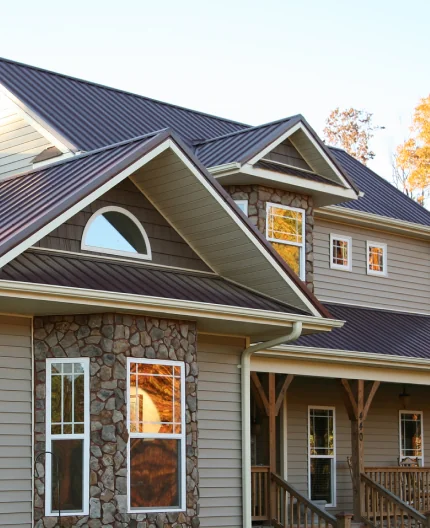Snow & Ice Damage
Snow damage to roofs isn’t always easy to see
No matter the time of year, water can cause problems for your roof. During the winter, as snow and ice begin to build up on your roof, many homeowners think they’re safe from the effects of water damage since the water is frozen, but that’s certainly not the case.
Snow and ice can damage your roof by thawing and refreezing as temperatures fluctuate. As snow and ice melt, water seeps into small holes in your roof. When temperatures dip back down and the water freezes again, it will expand, ripping open those holes and letting more water enter come the next thaw.
If your roof is in healthy condition, it should be able to support up to 20 pounds of weight, which equates to roughly 4 feet of snow. However, older, weathered roofs may not be able to effectively support that much weight, causing a sagging roofline that’s a clear indication of damage and wear.
There are several other signs of snow damage to your roof homeowners should look out for throughout the winter season, like ceiling leaks and large icicles accumulating along your roofline. Icicles are one of the biggest signs that your roof is suffering from ice dam damage — a major problem for roofs in the winter that can lead to leaks, structural damage and health hazards if not addressed.
Read More: Your home is subject to roof damage year-round: Here’s what you can do
What are ice dams?
Ice dams mainly form due to uneven roof temperatures from poor ventilation. This causes warm air in your attic to heat up the underside of your roof, melting the ice and snow above it. As the water runs down your roof to the colder edges, it freezes again, creating large blocks of ice that can jam gutters.
Gutter blockages prevent meltwater from running off your roof and can force moisture back up under your shingles and into your roof. As ice dams grow, they can create icicles heavy enough to tear down gutters, eaves and shingles, in addition to creating safety hazards for anyone walking beneath them.
Roof ice dam removal
To get rid of ice dams, you first need to identify where the ice dams are located on your roof. If they’re too out of reach, you may need to call a professional roof cleaner from the start.
However, if the ice dams center around your gutters and you’re comfortable being up on a ladder, then step one is applying an ice-melting product to break up the dam. Once the dam has been taken care of, be sure to remove any snow from your roof that could cause another dam to form in the future. If you have a low slope roof or a flat roof, this may be achieved by using a roof rake.
Ice dam removal isn’t a one-and-done process, so it’s important to keep up with maintenance as long as the temperatures are below 32°.
Note: Roof work can be extremely dangerous and should not be attempted by inexperienced persons. We always recommend contacting a professional for assistance with roofing concerns.
Read More: DIY roofing is not recommended: Here’s why
Roof ice dam prevention
A properly vented roof is your number one defense against ice dams and snow roof damage. Ventilation allows warm air to escape your attic and prevents heat from building up beneath your roof. Quality underlayment installed during a roof installation or replacement is another element of your roof system that keeps melted water from entering your roof decking and causing problems.
Other roof ice dam prevention tips include:
- Getting your gutters cleaned before winter weather sets in.
- Insulating your attic floor to keep heated air from entering your attic.
- Hiring a professional to clear snow off your roof.
Read More: How to prevent seasonal roof damage
It’s often the things you don’t see that matter the most.
Our customers expect high-caliber products and craftsmanship when they sign a contract with us for a new roof, and we make sure to deliver on those expectations. As a result, we’ve earned the SELECT ShingleMaster™ roof replacement accreditation — a special distinction given to less than 1% of roofers in the country.
We offer only the best products on the market, including the CertainTeed Integrity Roof System®. This sturdy, full-roof system features:
- Winterguard waterproof underlayment
- Roofer’s Select or Diamond Deck high-performance underlayment layers
- CertainTeed shingles
- Installation of ridge vents, hip and ridge caps, drip edge, new metal flashing and specified intake venting
Read More: Does insurance pay for a new roof?
Whether rain, sleet, snow or hail — you’re covered
At LONG, we pride ourselves in the quality of our products and service. In fact, we’re so confident in how long your new roof will last that we’re willing to guarantee it for 50 years.
Our SureStart PLUS five-star, 50-year warranty includes the cost of shingles and labor for any future repairs and also provides non-prorated coverage throughout the protection period. We even offer transferable warranties, so when you sell your home, the new homeowner can enjoy the protection of that 50-year warranty — a major selling point!
75 years of experience. 75 years of happy customers.
We’ve been in business for the last 75 years, and over time, our commitment to quality in everything we do has earned us a reputation that people trust. With our 4.6-out-of-5-star rating based on over 5,000 reviews on GuildQuality, we’ve proven to our customers that we mean what we say when it comes to quality home improvement.
If you recognize signs of snow or ice dam damage to your roof, it’s best to call in the pros before the damage spreads. Call the experts at Long Roofing online to schedule your roof replacement today.



